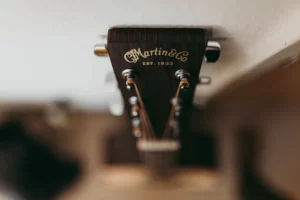Do you know any fretted instruments? Yes, that is a guitar. You can tell right away. The fretboard contains elevated metal strips. However, almost all other stringed instruments, such as the violin, viola, cello, double bass, and so on, do not contain these frets. Why are they only found on guitars? What are they for, and how do they affect the player? And how many frets are on a guitar in the first place?
We’ll go through all these topics and more, beginning with the one that most likely led you here.
What are frets?
Guitarists generate notations of varying tones by simplifying the size of the strings. This is done by tying the strings to the neck, especially in the areas between the ferromagnetic cable attached to the neck. Such metallic wires are called frets, which are spaced precisely apart.
Carrying the strings in between areas, near but not on the frets, lessens the cords and raises the pitch. Once you hold the strings, even though you drop down the fingerboard and connect to the space in which the body of the musical instrument meets the neck, the pitch rises. Frets also function as reference focuses on the fretboard, enabling it to locate notes.
How Many Frets Are On A Guitar?
A guitar typically has between 19 and 24 frets. The number of frets affects the range of notes that the instrument can produce. More frets mean a better content of notes. Let’s get to know the number of frets on different guitars:
Fret on Basic Classical Guitars
There are usually nineteen (19) frets on classical guitars, regarding a tuning source system called the ‘equal temperament octave,” also defined as a Fret Rule for Guitars. Producers use this mathematical equation or procedure to calculate fret placing regarding semitones.
It may appear unclear initially, particularly if you’re unfamiliar with musical definitions and concepts. For the time being, all you need to realize is that the fret principle affects frets that are an octave apart.
Frets On Electric Guitars
Again, there will be some size variations. This is due mainly to the demands of certain genres and, as a result, the demands of the guitarist. The majority of electric guitars have between 21 and 24 frets, all of which are available to play due to the body frame and cutaways.
When playing higher, the body interconnects to the neck around the 16th or 17th fret and doesn’t inhibit the hand excessively. These are among the guitars that are suitable for play in various genres. However, guitars are designed especially for players who need to reach higher the fretboard for ear-splitting guitar riffs.
Fret On Acoustic Guitars
The total frets over an acoustic guitar are generally less than that of an electric guitar. The acoustic neck meets the body at the 12th fret on standard classical and flamenco guitars, which have 19 frets (at the heel).
On traditional guitars, the soundhole placing normally implies that the fingerboard ends around the fret 18 or 19. Steel-stringed acoustic basses generally have 18 to 20 frets, with 12 to 14 frets far above the body (there will usually be 6 to 8 frets between where the neck meets the body and the soundhole).
Guitars are typically referred to as “12 frets’ or “14 fret.’ It also relates to the number of frets between the nut and the body, and players usually favor either. Even so, not all steel-string acoustics are the same. Small guitars (small guitars) typically have fewer frets. Before you move forward read How Many Strings Does A Guitar Have? to better understand the distribution of frets on a guitar.
Why aren’t there more frets on acoustic instruments? Frets above 12 become extremely difficult to play, especially for chords. Yes, cutaways assist. However, the frame of the guitar still restricts you.
Is the total number of frets important?
Although the numerical distinction between 19 frets and 24 frets is only 5, the count of frets on a guitar matters much more than the number 5 may suggest.
Here’s everything you want to learn about 24-fret guitars and those with fewer.
Differences In Aesthetic Appeal
This may seem trivial to some guitar players, but some other performers enjoy noticing additional frets on their instruments. Having two full octave ranges on a guitar can give you a feeling of achievement. All who enjoy picking up guitars would like at least one with added frets, correct? Other frets equal a more playable tone.
Possessing more frets on your guitar implies you’ll have more high-pitched playable intonations. Consider it this way: you have 2 more halftones on the high E string of your 24-fret guitar (assuming basic tuning) versus a 22 one, providing you with 2 full octaves.
You Can Enjoy A Higher E Note On The 24th Fret. Is That Critical?
Yes, for specific music. For instance, if you would like to play Metallica’s Master of Puppets, you can’t (unless you’re tearing) even though Kirk utilizes both the 23rd and 24th frets on the higher E string. This added fret concept, even so, does not apply to other lower strings.
You will get a full tone on the numerous strings, but this doesn’t matter since you can also play these notes on a guitar with 22 frets. They may be more difficult to play but still contain identical notes.
The Number Of Frets Affects Playability
If you desire to perform all doable notes and strings, you must have flexibility and great physical quickness. You might need to swap from enjoying one string to the other to sing specific songs. You can play further notes with many more frets without using relatively high strings. And it is much easier to play the notes and strings you use if they’re on the extra 23rd and 24th frets.
One option is to play middle C on the musical instrument, for instance, via the 20th fret of the 6th string. This spot is hardly ever used, but you lack the choice if you have a 19-fret acoustic guitar. Even so, there are some limitations to electrical guitar design with additional frets, the most significant of which is the pickups. Reaching these extra numbers on such guitars can be difficult unless you’re using one with a dual-cut body frame or a personalized flat neck heel.
Is it Essential to Have 24 Frets?
Are you truly require a large number of frets on your guitar? Is there a big deal if your instrument has fewer than 24 frets? In most cases, no. The 23rd and 24th frets are rarely for use in songs. If you don’t play hardcore steel or rock ‘n’ roll, you’ll almost certainly never want to perform the notations back the 20th fret.
The need for more than 20 frets is decided by the style of music you will be playing. Whether a guitar has fewer or more frets is a matter of preference. For example, one of these simple metal riffs uses to perform on a guitar with 22 frets.
What Are The Dots On A Frets For?
Nowadays, when you learn a little bit more about frets, you’ll wonder what all the dots between the frets on the guitar fretboard are for. These dots (also known as inlays) are indications that are glued or painted on the surface of the guitar fretboard. The majority of guitars include these markers, but some do not. The dots, like frets, let guitarists go from one place to another on the fingerboard faster, accurately, and easily.
When playing chords, tones, or levels on the guitar, you may utilize the dots to rapidly locate the position of each fret without having to check at the neck or fingerboard. For example, if you’re playing with pals and need to get to the seventh fret, check for the third inlay or dots on the seventh fret. In many other terms, these dots can act as visual cues, making fret leaping simpler and faster.
Final Thoughts
Most guitars feature frets since they make it much simpler to play chords properly. You’d find it difficult to put each finger lacking frets, but with frets, you need to arrange them beyond the fret to ensure that the string gets in touch with it.
So, how many frets are on guitar? The number varies, but it is usually 22 on a competent electric guitar and 19 on a classical guitar, which is sufficient for most individuals. If you wish to shred, you would like a guitar with 24 frets, which many top metal guitars have.
FAQs
How Many Frets Are There On A Standard Guitar?
Acoustic and electric guitars have variable fret counts, with acoustics often having fewer frets than electrics. Acoustic guitars typically have 19 and 24 frets, with 20 as the most frequent. Electric guitars, on the other hand, will often have from 21 and 24.
What Is The Most Fretted Guitar?
Electric guitars have the greatest fret variations, ranging from 21 to 24. Here are several examples: Fender Telecaster and Stratocaster: Originally had 21 frets, but in the 1980s began selling 22-fret necks. Gibson Les Paul has 22 frets and connects to the body at the 16th fret.
Are 12-Fret Guitars Superior?
Students and smaller players might discover 12-fret simpler and much more relaxing to play when their fretting finger does not need to extend far to get the available position. It all simply refers to tone, aesthetics, and what feels good for the player in the end.







